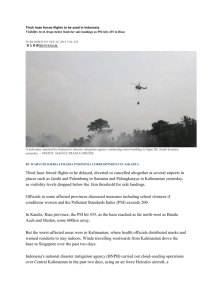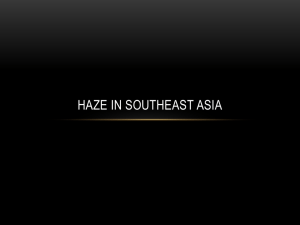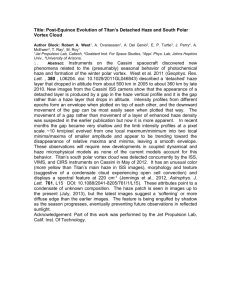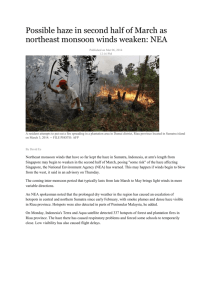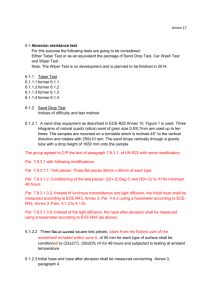Document 12152326
advertisement
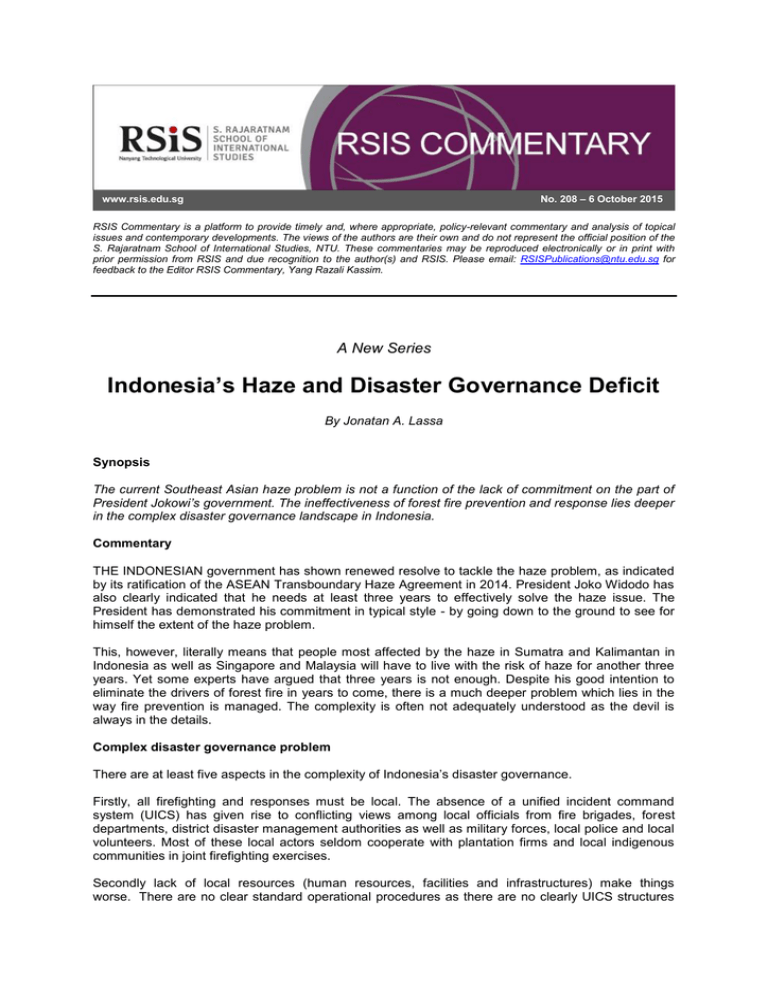
No. 208 – 6 October 2015 www.rsis.edu.sg RSIS Commentary is a platform to provide timely and, where appropriate, policy-relevant commentary and analysis of topical issues and contemporary developments. The views of the authors are their own and do not represent the official position of the S. Rajaratnam School of International Studies, NTU. These commentaries may be reproduced electronically or in print with prior permission from RSIS and due recognition to the author(s) and RSIS. Please email: RSISPublications@ntu.edu.sg for feedback to the Editor RSIS Commentary, Yang Razali Kassim. A New Series Indonesia’s Haze and Disaster Governance Deficit By Jonatan A. Lassa Synopsis The current Southeast Asian haze problem is not a function of the lack of commitment on the part of President Jokowi’s government. The ineffectiveness of forest fire prevention and response lies deeper in the complex disaster governance landscape in Indonesia. Commentary THE INDONESIAN government has shown renewed resolve to tackle the haze problem, as indicated by its ratification of the ASEAN Transboundary Haze Agreement in 2014. President Joko Widodo has also clearly indicated that he needs at least three years to effectively solve the haze issue. The President has demonstrated his commitment in typical style - by going down to the ground to see for himself the extent of the haze problem. This, however, literally means that people most affected by the haze in Sumatra and Kalimantan in Indonesia as well as Singapore and Malaysia will have to live with the risk of haze for another three years. Yet some experts have argued that three years is not enough. Despite his good intention to eliminate the drivers of forest fire in years to come, there is a much deeper problem which lies in the way fire prevention is managed. The complexity is often not adequately understood as the devil is always in the details. Complex disaster governance problem There are at least five aspects in the complexity of Indonesia’s disaster governance. Firstly, all firefighting and responses must be local. The absence of a unified incident command system (UICS) has given rise to conflicting views among local officials from fire brigades, forest departments, district disaster management authorities as well as military forces, local police and local volunteers. Most of these local actors seldom cooperate with plantation firms and local indigenous communities in joint firefighting exercises. Secondly lack of local resources (human resources, facilities and infrastructures) make things worse. There are no clear standard operational procedures as there are no clearly UICS structures available in all districts. What we see today is collective failure of about 100 out of 211 districts/cities governments in Sumatra and Kalimantan that in theory justified a proper response from the central government. When forest fire turns into a transboundary haze catastrophe because local capacity at districts and provinces is no longer adequate, the central government must act accordingly. Thirdly, the absence of UICS at the national level has also led to ineffective response. Every agency seems to be taking command, confusing the public as to who should be the leading and who is the central authority in dealing with forest fire prevention and haze response. In normal times, the Ministry of Environment and Forestry (MoEF) is the mandated agency that often receives fiscal allocation for fire prevention, fire preparedness and firefighting responses. Fourthly, in the Law 26/2014 regarding ratification of the ASEAN Agreement On Transboundary Haze Pollution, only five parallel Indonesian laws are mentioned, with no reference to the National Disaster Management Agency (BNPB) : the Forestry Law 41/1999; Plantation Law 18/2004 that regulates obligation of plantations in regard to forest fire; Local Government Law 32/2004 (compliance with local government systems); Meteorology, Climatology and Geophysical Law 31/2009 (the need for hotspot monitoring etc.); and Environment Protection and Management Law 32/2009. The law 26/2014 does not seem to extend to the role of the BNPB because the law is directly translated from the ASEAN agreement on haze pollution. Furthermore, the drafters of the law either ignored or failed to understand the role of BNPB in responding to crisis caused by forest fire. Yet de facto, BNPB is the most equipped agency for emergency response, though it does have limited capacity for large-scale firefighting responses. Finally, public relations (PR) problems a la Jokowi could be one of the culprits. His decision to have no centralised PR system is not conducive for complex crisis management. Different ministries and agencies give contradictory responses. The Ministry of Environment and Forestry argued earlier that Indonesia needed no help – and suggested that Singapore’s offer of help was insignificant. The vice president’s office argued differently. The Chief of Staff under the President’s Office seems to prioritise responses to the complaints from social media from Singapore. Yet the fact is that at least 20-25 million people in Sumatra and Kalimantan have been affected and thousands of small babies and children suffer from acute respiratory problems. There have been pressures from the people via social media for the government to declare a national disaster, allowing greater allocation of resources from the central government. However, BNPB insisted that the present Southeast Asian haze does not qualify to be declared a national disaster. BNPB argued against declaring the haze catastrophe as a national disaster as it may signal a lack of national resilience. More than 110,000 people have suffered respiratory diseases such as acute respiratory infection and similar ailments, while hundreds of thousands of people are potential patients from across five provinces in Kalimantan and Sulawesi. We are also looking at potentially huge economic losses in three countries, yet the BNPB is insisting that the disaster is still ‘local’ in scale. What can be done in the short term? Improvement in public relations in crisis situations must be a critical part of the unified incident command system. In the short term, if fire and haze are predicted to continue till November, it is urgent for the President to declare the haze a national disaster using his presidential prerogative and establish a unified incident command system. This will enable him to pull in more domestic resources and allow international partners to help resolve the problem more expeditiously. Mobilising Indonesian military assets and capacity can also help improve the effectiveness of national and local responses to the haze. Meanwhile, ASEAN can be allowed to be more proactive in helping Indonesia, though, as regulated by the Haze Agreement, ASEAN can only “respond to a request for or offer of assistance in the event of land and/or forest fires or haze pollution resulting from such fire”. There is more hope for collective action from civil society as well as from survivors/victims. Civil society needs to create long-term pressure both at the local and national levels concerning accountability in haze management. Jonatan A. Lassa is Research Fellow at the Centre for Non-Traditional Security Studies (NTS) S. Rajaratnam School of International Studies Nanyang Technological University, Singapore. This is part of a new RSIS series on the regional haze issue. Nanyang Technological University Block S4, Level B4, 50 Nanyang Avenue, Singapore 639798 Tel: +65 6790 6982 | Fax: +65 6794 0617 | www.rsis.edu.sg

